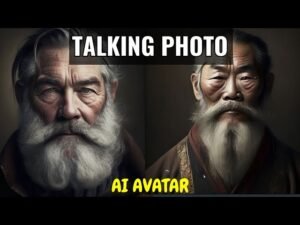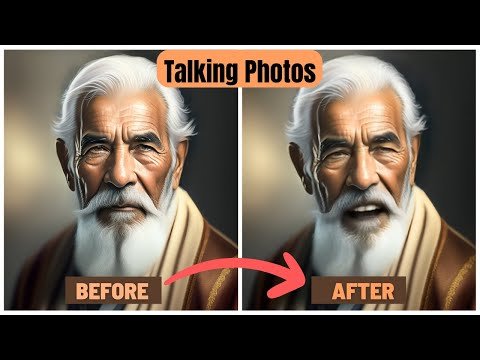Artificial Intelligence (AI) continues to revolutionize various sectors, including entertainment and communication. One of the latest innovations in this field is the AI talking photo, a technology that brings static images to life by making them speak. This advancement captivates users by blending visual art with natural language processing, offering both entertainment and functional applications. In this article, we’ll explore what AI talking photos are, how they work, their features, pros and cons, alternatives, and conclude with a comprehensive verdict on this intriguing technology.
What is AI Talking Photo?
An AI talking photo is a digital image that is enhanced using artificial intelligence to simulate speech. This technology can animate the facial features of a photograph to match the synchronized audio, making it appear as though the person in the image is speaking. The applications for AI talking photos are vast, ranging from creating dynamic content for social media, educational tools, and virtual assistants, to preserving and sharing memories in a more engaging way.

How AI Talking Photos Work
AI talking photos leverage several sophisticated technologies to achieve their lifelike animations. Here’s a breakdown of the process:
- Image Analysis and Processing: The AI begins by analyzing the facial features in the photograph. It maps out critical points such as the eyes, mouth, and facial contours to understand the structure of the face.
- Speech Synthesis: Text-to-speech (TTS) technology generates audio from written text or pre-recorded voice samples. This audio serves as the basis for the lip-syncing animation.
- Lip-Sync Animation: Advanced algorithms synchronize the movements of the mouth and other facial features with the generated speech. This involves creating a sequence of frames that mimic natural speech patterns and facial expressions.
- Deep Learning Models: The entire process is powered by deep learning models that have been trained on vast datasets of human faces and speech. These models can predict and generate realistic facial movements based on the input audio.
- Rendering: The final step involves rendering the animated photo, producing a video file that appears as though the person in the photograph is talking.
Features of AI Talking Photo
AI talking photos come with a variety of features that enhance their functionality and user experience. Below is a detailed look at some of the most prominent features:
User-Friendly Interface
Most AI talking photo applications are designed with a user-friendly interface, making it easy for users of all skill levels to create talking photos. Intuitive controls and step-by-step guides help users through the process of uploading photos, adding text, and generating animations.
High-Quality Animation
Advanced AI models ensure that the animations are smooth and realistic. High-resolution image processing and sophisticated rendering techniques contribute to a high-quality final product.
Customizable Voices
Users can choose from a range of synthetic voices to find the perfect match for their talking photo. Some applications also allow users to upload their own voice recordings for a more personalized touch.
Multi-Language Support
AI talking photo technology often supports multiple languages, allowing users to create animations in various languages and accents. This feature is particularly useful for global applications and educational purposes.
Integration with Social Media
Many AI talking photo tools offer direct integration with social media platforms, making it easy for users to share their creations on Facebook, Instagram, Twitter, and other networks.
Real-Time Preview
Real-time preview features enable users to see the animation process as it happens. This allows for adjustments and fine-tuning before finalizing the animation.
Emotion and Expression Controls
Advanced AI talking photo applications offer controls for adding different emotions and expressions to the animated photos. Users can make the subjects look happy, sad, angry, or surprised, adding an extra layer of depth to their creations.
Cloud-Based Processing
Many AI talking photo applications use cloud-based processing, which means users do not need powerful hardware to create animations. The heavy lifting is done on remote servers, making the process faster and more accessible.
Security and Privacy
Top-tier AI talking photo tools prioritize user security and privacy. They implement robust data protection measures to ensure that user photos and voice data are handled securely.
Pros of AI Talking Photos
| Pros | Details |
|---|---|
| Engaging Content Creation | AI talking photos can create highly engaging and dynamic content for social media, marketing, and educational purposes. |
| Personalization | Users can personalize messages with custom voices and expressions, adding a unique touch to their creations. |
| Accessibility | Multi-language support and intuitive interfaces make this technology accessible to a wide audience. |
| Entertainment | AI talking photos provide a fun and novel way to interact with digital images, offering entertainment for both creators and viewers. |
| Educational Tools | These animations can be used in educational settings to create interactive and immersive learning experiences. |
| Memory Preservation | AI talking photos can be used to bring old family photos to life, adding a new dimension to personal memories. |
| Marketing Potential | Brands can leverage this technology to create innovative and attention-grabbing advertisements. |
| Time-Saving | Automation of the animation process saves time compared to manual animation techniques. |
Cons of AI Talking Photos
| Cons | Details |
|---|---|
| Ethical Concerns | The realistic nature of AI talking photos raises ethical questions about consent and the potential for misuse. |
| Privacy Risks | Handling of personal photos and voice data may pose privacy risks if not managed properly. |
| Cost | High-quality AI talking photo tools can be expensive, potentially limiting access for some users. |
| Technical Limitations | Despite advancements, some animations may still appear unnatural or flawed, depending on the quality of the input image and the complexity of the animation. |
| Dependency on Technology | Reliance on cloud-based processing requires a stable internet connection and raises concerns about data security. |
| Legal Issues | There could be legal implications regarding the use of someone else’s image or voice without proper authorization. |
| Potential for Misuse | The technology can be used to create deepfakes or misleading content, which can have serious societal implications. |
| Learning Curve | Although designed to be user-friendly, there may still be a learning curve for some users to achieve desired results. |
AI Talking Photo Alternatives
| Alternative | Description | Pros | Cons |
|---|---|---|---|
| Deepfake Technology | Uses AI to create realistic videos of people saying or doing things they never did. | Highly realistic results, broad applications. | Ethical concerns, potential for misuse, requires advanced skills. |
| Avatar-Based Systems | Creates animated avatars that can speak and express emotions. | Easy to use, customizable avatars, good for branding. | Less realistic than AI talking photos, can be expensive. |
| Traditional Animation | Manual animation techniques to create talking characters. | Complete creative control, no reliance on AI. | Time-consuming, requires artistic skills, labor-intensive. |
| Lip-Sync Software | Specialized software for synchronizing audio with pre-existing animations. | Precision control over lip-sync, used in professional settings. | Requires technical expertise, not suitable for static photos. |
| Video Editing Tools | Software like Adobe After Effects to manually animate mouth movements. | High-quality results, flexible. | Steep learning curve, time-consuming, requires technical skills. |
| Voiceover Applications | Adds voiceovers to photos without animation. | Simple to use, quick results. | Lacks visual animation, less engaging. |
| GIF Animations | Creates simple animations from photos, often with added text or effects. | Easy to create and share, widely supported. | Limited animation capabilities, not suitable for speech synchronization. |
| Face Swap Apps | Apps that swap faces in videos or photos. | Fun and engaging, easy to use. | Can be unrealistic, potential privacy concerns. |
Conclusion and Verdict on AI Talking Photos
AI talking photos represent a fascinating intersection of technology and creativity, offering a multitude of applications across various domains. The ability to bring static images to life with realistic speech and expressions can transform how we create and consume digital content. However, this technology is not without its challenges and ethical considerations. While it offers engaging and personalized content creation, it also raises questions about privacy, consent, and potential misuse.
In conclusion, AI talking photos are a powerful tool for those looking to innovate in digital storytelling and communication. With continuous advancements in AI and deep learning, we can expect this technology to become even more refined and accessible. However, users and developers must navigate the ethical landscape carefully to ensure responsible use. For those willing to explore its possibilities while being mindful of its limitations, AI talking photos offer a compelling and versatile medium.
FAQs on AI Talking Photos
1. What are AI talking photos? AI talking photos are digital images enhanced with artificial intelligence to simulate speech, making the subject in the photo appear as though they are talking.
2. How do AI talking photos work? They work by analyzing facial features in a photo, generating speech from text or voice samples, and synchronizing facial animations with the generated audio using deep learning models.
3. What are some applications of AI talking photos? Applications include social media content creation, educational tools, virtual assistants, personalized messages, marketing, and preserving memories.
4. Are AI talking photos easy to create? Yes, most AI talking photo applications are designed with user-friendly interfaces, making it accessible to users of all skill levels.
5. What are the ethical concerns associated with AI talking photos? Ethical concerns include privacy risks, potential misuse for creating misleading content, and the need for consent when using someone else’s image or voice.
6. Can I use my own voice in an AI talking photo? Yes, many applications allow users to upload their own voice recordings for a more personalized touch.
7. Are AI talking photos available in multiple languages? Yes, many AI talking photo tools support multiple languages and accents.
8. What are the costs associated with AI talking photos? Costs can vary, with some high-quality tools being expensive. However, there are also free or affordable options available with basic features.
9. How secure is my data when using AI talking photo applications? Top-tier applications prioritize user security and privacy, implementing robust data protection measures. It’s important to choose reputable tools.
10. Can AI talking photos be shared on social media? Yes, many AI talking photo applications offer direct integration with social media platforms for easy sharing.




